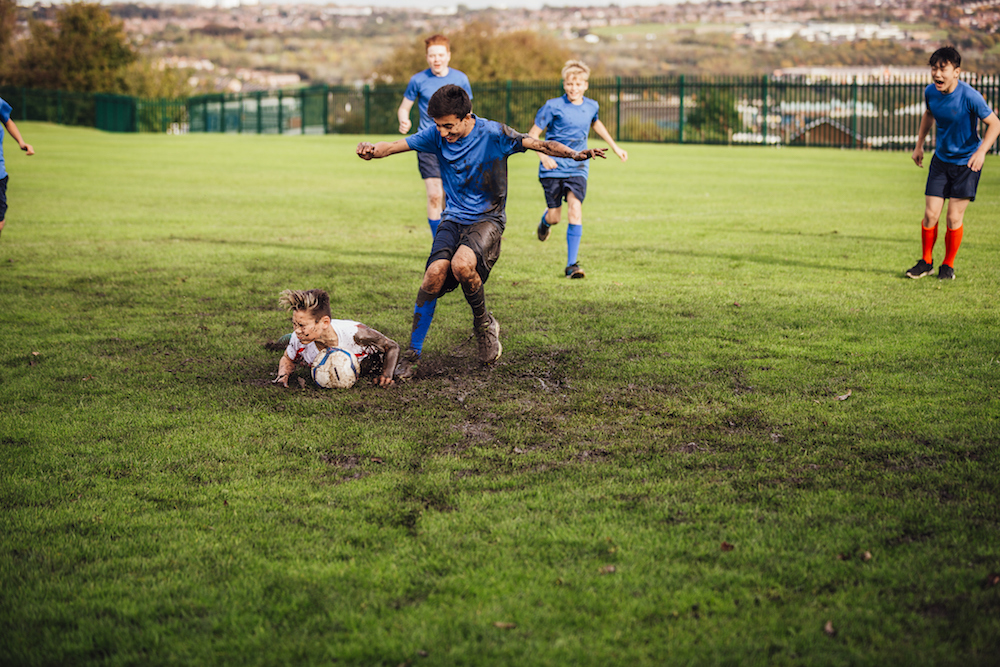
Getty Images
When our young children and adolescents are at play or competing, regardless of the activity, safety should always be a top priority for observing parents, caretakers, coaches/trainers, etc. However, preventing an injury from occurring is no easy feat for most physical activities and contact sports such as football, soccer, lacrosse or ice hockey.
In this case, we can each play a part in keeping our athletes safe by (1) learning about the signs/symptoms associated with common sports-related injuries and (2) taking necessary action when a player is injured. Let’s start with the concussion; this is one of the most frequently-occurring and potentially dangerous injuries to keep an eye out for.
To clarify what we’re dealing with – a concussion is a type of traumatic brain injury (TBI) sustained from a bump/blow to the head or body, causing the brain to bounce or twist in the skull and disrupting normal function of the brain. Even though most people will recover from a concussion within a couple of days or weeks, some will have enduring symptoms that last for months or longer.
While typically classified as mild TBIs, concussions are still dangerous and commonly left untreated. Nearly 2.8 million sports/recreational concussions occur every year, but only 1 in 6 of them are actually diagnosed. In addition, 25 to 50 percent of all concussions reported to emergency centers are sustained from sports/recreational activities.
If you witness a collision, fall or moment of impact, don’t rule out a sustained concussion if the player:
- seems confused or dazed
- can’t recall events prior to (or after) impact
- forgets instruction, position or move from playbook
- is moody, irritable or changes behavior
- is clumsy or off-balanced
- exhibits slow or slurred speech
It’s safe to suspect a concussion and intervene if the player reports the following symptoms:
- headache or migraine
- nausea or vomiting
- dizziness or double vision
- sensitivity to bright light or loud noises
- lethargy, tiredness
- inappropriate laughing or crying
- difficulty remembering simple tasks/plays
In severe cases, a hematoma (collection of blood) might form and put pressure against the brain. The following red flags warrant immediate medical evaluation at the nearest emergency center:
- inability to wake up, intense drowsiness
- severe, worsening headache
- seizure activity (shaking or twitching)
- excessive or repeated vomiting
- agitation or abnormal behavior
- loss of consciousness (even if brief)
- dilated pupil
- worsening neurological exam – warranting repeat of exam
The symptoms associated with a concussion will usually appear within the first couple of minutes or hours after sustaining the injury. However, it’s important to monitor the player throughout the following days, as some symptoms might progress or worsen.
If a concussion is suspected, it’s up to someone (coach, trainer, family member) to remove the player from the game or activity for a formal assessment. It may not be possible to make an initial diagnosis given the circumstances, but a decent preliminary evaluation can be obtained from details of the injury, reported symptoms and exam findings.
There are many concussion assessment tools used by athletic trainers and medical professionals, such as the SCAT5 (sport concussion assessment tool). Most were created to help evaluate a player’s orientation, symptoms, gross cognition and physical exam results. The following may be used to evaluate the injured:
- balance – eyes are closed while standing on both legs, then each individual leg
- neurocognitive testing – repeat three to five words, concentration is tested by counting numbers backwards, delayed recall memory is tested by recalling same three to five words later
When a concussion is suspected, it’s better to err on the side of caution and remove the player from the activity until cleared by a health care provider. Don’t try to judge the severity of an injury yourself. If we’re all vigilant of these signs, symptoms and red flags, our young ones will be much better off in the event of a concussion.
Returning to play:
The injured should only return to physical play/training after receiving written approval from their health care provider. The CDC recommends six gradual steps for recovering players, parents, coaches/trainers and medical professionals to adhere to.
Step 1: return to school (classroom) activities
Step 2: light aerobic activity – five to 10 minutes of light jogging, low-level intensity exercise in some cases, NO weight-lifting
Step 3: moderate activity – brief running, moderate intensity exercise, weight-lifting (use lighter weight when starting)
Step 4: heavy, non-contact physical activity – sprinting, running, normal weight-lifting and non-contact sports drills
Step 5: full-contact practice – return to normal athletic activity in controlled environment of practice
Step 6: return to competition
These steps are gradual and not intended to be completed in a day or two. If a player begins to redevelop concussive-like symptoms, they need to stop all activity and contact their medical provider. Players should only progress to the next step if symptoms are alleviated.
You might be in a different scenario where this six-step process doesn’t apply. Whichever strategy is desired, it’s important to adhere to the advice and recommendations of the player’s health care provider and aid the player in reporting any new signs or symptoms during recovery.
[watch:] Orthopedics and Sports Medicine Clinic at Texas Children’s Hospital The Woodlands (YouTube)
References: